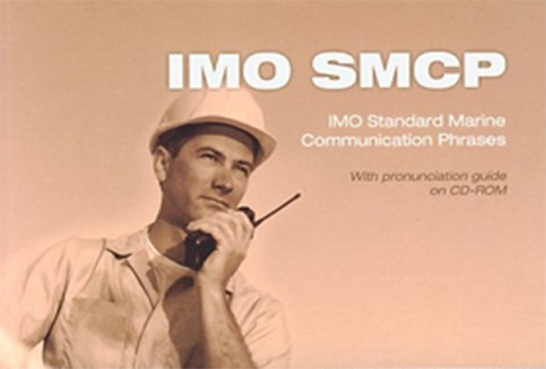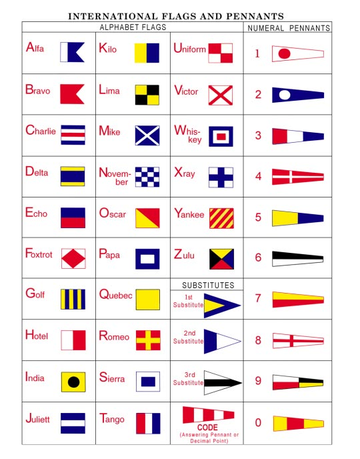Analyses of marine casualties and accidents investigation reports show recurrent cases of ineffective Bridge Resource Management; particularly the ineffective relationships between master, crew, pilot and shore personnel.
Communication difficulties often occur in these areas not just due to cultural differences but also due to language 'barriers'.
In the world of international shipping, with seafarers from different countries sailing on ships trading to all parts of the world, effective communication between those on board, and between ship and shore is vitally important.
Presently, there is no recognised international or European standards for the assessment of English language for seafarers. According to recent IMO statistics, 80% of accidents occurring at sea are caused by human errors, with half due to poor communication.
When communicating between ship-to-ship and ship-to-shore through radio-telephony, the ship or shore may use either of the following:
Standard Marine Communications Phrases (SMCP)
IMO's Standard Marine Communication Phrases (SMCP) were adopted by the 22nd Assembly in November 2001 as resolution A.918(22) IMO Standard Marine Communication Phrases.
The IMO SMCP replace the Standard Marine Navigational Vocabulary (SMNV) which was developed for use by seafarers, following agreement that a common language - namely English - should be established for navigational purposes where language difficulties arise.
The IMO SMCP has been developed as a more comprehensive standardized safety language, taking into account changing conditions in modern seafaring and covering all major safety-related verbal communication.
The IMO SMCP builds on a basic knowledge of English and has been drafted in a simplified version of maritime English.
It includes phrases for use in routine situations such as berthing as well as standard phrases and responses for use in emergency situations.
Under the International Convention on Standards of Training, Certification and Watchkeeping for Seafarers (STCW), 1978, as amended, the ability to understand and use the SMCP is required for the certification of officers in charge of a navigational watch on ships of 500 gross tonnage or above.
Spelling of Letters
| Letter |
Code |
| A |
Alfa |
| B |
Bravo |
| C |
Charlie |
| D |
Delta |
| E |
Echo |
| F |
Echo |
| G |
Golf |
| H |
Hotel |
| I |
India |
| J |
Juliet |
| K |
Kilo |
| L |
Lima |
| M |
Mike |
| N |
November |
| O |
Oscar |
| P |
Papa |
| Q |
Quebec |
| R |
Romeo |
| S |
Sierra |
| T |
Tango |
| U |
Uniform |
| V |
Victor |
| W |
Whiskey |
| X |
X - ray |
| X |
Yankee |
| Z |
Zulu |
Spelling of Digits and Numbers
A few digits and numbers have a modified pronunciation to general English: -
| Number |
Spelling |
Pronunciation |
| 0 |
Zero |
ZEERO |
| 1 |
One |
WUN |
| 2 |
Two |
TOO |
| 3 |
Three |
TREE |
| 4 |
Four |
FOWER |
| 5 |
Five |
FIFE |
| 6 |
Six |
Six |
| 7 |
Seven |
SEVEN |
| 8 |
Eight |
AIT |
| 9 |
Nine |
NINER |
| 1000 |
Thousand |
TOUSAND |
International Code of Signals (ICS)
The purpose of the ICS is to provide ways and means of communication in situations related essentially to safety of navigation and persons, especially when language difficulties arise.
It has done this by first establishing a standardized alphabet (the letters A to Z and the ten digits), along with a spoken form of each letter (to avoid confusing similar-sounding letters, such as 'b', 'p', and 'v'), and associating this alphabet with standardized flags.
Combinations of these alphanumeric characters are assigned as codes for various standardized messages.
Phonetic alphabet spelling
May be used when transmitting plain language or code: -
| Letter |
Word |
Pronounced as |
| A |
Alfa |
AL FAH |
| B |
Bravo |
BRAH VOH |
| C |
Charlie |
CHARLEE or SHAR LEE |
| D |
Delta |
DELL TAH |
| E |
Echo |
Ech o |
| F |
Foxtrot |
FOKS TROT |
| G |
Golf |
GOLF |
| H |
Hotel |
HOH TELL |
| I |
India |
IN DEE AH |
| J |
Juliet |
JEWLEEETT |
| K |
Kilo |
KEY LOH |
| L |
Lima |
LEE MAH |
| M |
Mike |
MIKE |
| N |
November |
NO VEM BER |
| O |
Oscar |
OSS CAR |
| P |
Papa |
PAH PAH |
| Q |
Quebec |
KEH BECK |
| R |
Romeo |
ROW ME OH |
| S |
Sierra |
SEE AIR RAH |
| T |
Tango |
Tan go |
| U |
Uniform |
YOU NEE FORM or OO NEE FORM |
| V |
Victor |
VIK TAH |
| W |
Whiskey |
WISS KEY |
| X |
X-ray |
ECKS RAY |
| Y |
Yankee |
YANG KEE |
| Z |
Zulu |
ZOO LOO |
Note: The syllables to be emphasised are
boldfaced
Figure Spelling
May be used when transmitting plain language or code: -
| Figure or Mark to be transmitted |
Word |
Pronounced as |
| 0 |
NADAZERO |
NAH-DAH-ZAY-ROH |
| 1 |
UNAONE |
OO-NAH-WUN |
| 2 |
BISSOTWO |
BEES-SOH-TOO |
| 3 |
TERRATHREE |
TAY-RAH-TREE |
| 4 |
KARTEFOUR |
KAR-TAY-FOWER |
| 5 |
PANTAFIVE |
PAN-TAH-FIVE |
| 6 |
SOXISIX |
SAY-TAY-SEVEN |
| 7 |
SETTESEVEN |
SAY-TAY-SEVEN |
| 8 |
OKTOEIGHT |
OK-TOH-AIT |
| 9 |
NOVENINE |
NO-VAY-NINER |
| Decimal point |
DECIMAL |
DAY-SEE-MAL |
| Full stop |
STOP |
STOP |
Note: Each syllable should be equally emphasised
The Standard Marine Communication Phrases (SMCP) has been compiled to:
- assist in the greater safety of navigation and of the conduct of the ship,
- standardize the language used in communication for navigation at sea, in port-approaches, in waterways, harbours and onboard vessels with multilingual crews, and
- assist maritime training institutions in meeting the objectives mentioned above.
These phrases are not intended to supersede or contradict the International Regulations for Preventing Collisions at Sea, 1972, special local rules or recommendations made by IMO concerning ships' routeing. Neither are they intended to supersede the International Code of Signals. When applied on ship's external communication, this has to be done in strict compliance with the relevant radiotelephone procedures as set out in the ITU Radio Regulations. Furthermore, the SMCP, as a collection of individual phrases, should not be regarded as any kind of technical manual providing operational instructions.
The SMCP meets the requirements of the STCW Convention, 1978, as revised, and the SOLAS Convention, 1974, as revised, with regards to verbal communications and covers the relevant communication safety aspects laid out in these conventions.
The SMCP builds on basic knowledge of English language and is purposely drafted in a simplified version of Maritime English to reduce grammatical, lexical and idiomatic varieties to a tolerable minimum. It also uses standardized structures for the purpose of its functional aspects, i.e. diminishing misunderstanding in safety related verbal communications, so as to reflect present Maritime English language usage on board vessels and for ship-to-shore/ship-to-ship communications.


 Phonetic alphabet spelling
May be used when transmitting plain language or code: -
Phonetic alphabet spelling
May be used when transmitting plain language or code: -
